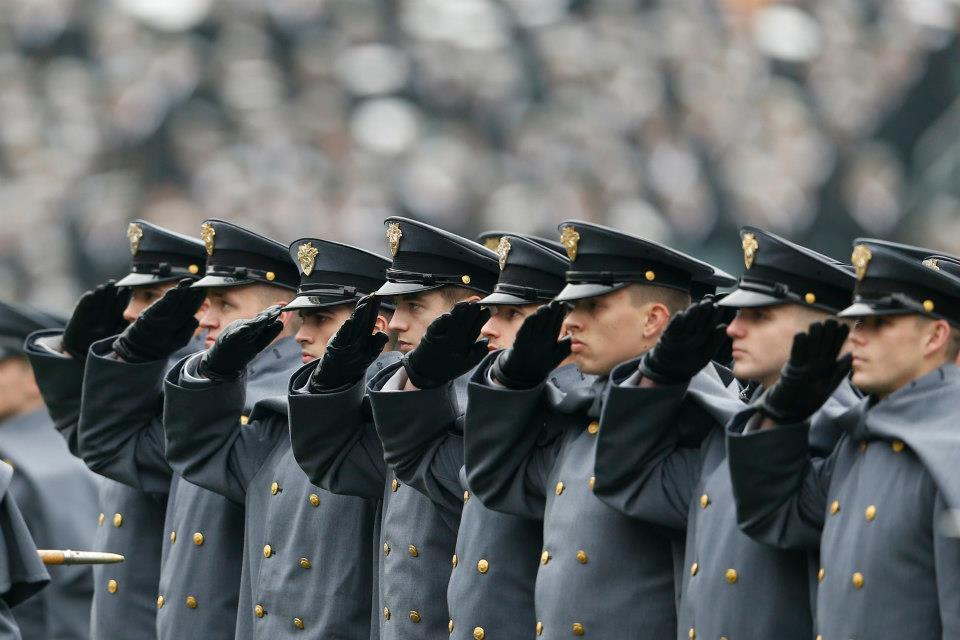The Gray Line: The Very Model of a Postmodern Military

When Kristine Potter’s collection of photographs titled The Gray Line were posted to Buzzfeed last week, the military and veteran community generally greeted it with derision. The pictures were deemed weird or gay or effeminate or really just not that good. This reaction led Potter to ask Buzzfeed, successfully, to remove the photos from their site. The photos do remain on the website Women in Photography, and I suggest our readers visit it and reconsider them.
Post-modernism has only aggravated the already fraught relationship between contemporary art and contemporary publics. It replaces the beautiful – traditionally nice or powerful pictures with vibrant colors – with a new type of sublime that values disharmony between our reason and our imagination. Subjects comfortable with art that pleases them are less comfortable with art that intends to unsettle them. This is compounded when it is difficult to understand the art readily or why artists should want to discomfort us. This last phenomenon creates its own cycle of complexity as post-modern art appeals to a continuously shrinking circle, compartmentalizing knowledge of the subject only to those that comprehend and appreciate it.
In reconsidering Potter’s work, we must keep in mind these post-modern ideas of disharmony, of the loss of narrative coherence. Let us begin with how we conceive of the military generally and the Military Academy specifically. We live in an age when gay soldiers are allowed to serve openly and when the military’s leadership is considering how to allow women into any job they can do. And yet the reaction to these photos, even from people I know to be mostly socially progressive, shows that many people still hold on to the soldierly ideal of the age of Don’t Ask, Don’t Tell and strict gender segregation in combat arms. It is an ideal that holds that soldiers should be strong, masculine, and exceptional and one that shuns weakness, femininity, and banality.
This ideal is magnified at West Point. It is an institution that sees itself as elite, exceedingly exceptional, extremely challenging, and endlessly interesting. It tells its candidates this, and it tells its cadets and graduates the same (which I can attest to as a graduate of the school). We – graduates, soldiers, veterans, citizens – accept this ideal as true and cringe at contradicting depictions. When Kristine Potter decided to create these portraits, a contradiction was inevitable. Apparently from a military family, the work on her website indicates that she specializes in bursting ideal mythologies of masculinity and exceptionalism. Her 2012-2014 collection Manifest takes the manly and majestic American West and portrays it as nearly everything but.
She took the same masculinity-debunking approach to The Gray Line, which also explains why there are no women as objects in the collection. She took the hyper-macho, exceptional, special cadets of West Point and portrayed them as excruciatingly normal, weak, or even uninteresting. They appear silly or incongruous to their surroundings. A number of the pictures have a homoerotic flair to them. In the text accompanying the collection on Women in Photography, Potter said she wanted to capture cadets before they became full-fledged men, attempting to “humanize the tough exteriors.” I do not think she goes far enough in her comments here, and I think that her perspective of the military goes beyond a reflection of adolescence. Like Manifest, she shows people how they are, individually and deeply personally, separate from the identifying role they play in society; that if you remove the label of cadet or soldier or cowboy, there is under that label a person who is probably not different from most people.
But more importantly, and likely unintentionally, Potter provides a valuable normative perspective on military life. She forces us to consider non-conforming ideas of what it means to be a soldier or a cadet. Each individual photograph is by itself an odd reflection of life at the United States Military Academy. But collectively we see a different potential, one that accepts sexual tension between men or implicitly argues that you do not need the jaw-line of a Disney prince to lead other soldiers. It is a reflection of people and not heroes, and the fact is, there is no single model for either at West Point.
As the U.S. Army continues its long journey into the modern world – a world that values the contributions of members previously deemed un-soldierly – Potter’s work allows us to consider a military different than the one we have today. She challenges us to adjust our reason to new and potential realities, realities portrayed through her imaginative photographs. I suggest that our readers embrace this disharmony while reconsidering both Potter’s work and their own understanding of what it means to be a soldier. Our nation will always need hard people who do hard things in order to keep it safe, but maybe we should cast loose our notions of what those people look like and who they are and judge them only on what they can do.
Jason Fritz is a senior editor at War on the Rocks. An Army veteran of the war in Iraq, he is a doctoral student in the Department of Justice, Law and Criminology at American University. Jason has consulted on and researched various elements of conflict policing over the past 5 years.
Photo credit: The U.S. Army

